
The Sugar Industry of Puerto Rico
 La industria del azúcar en Puerto Rico La industria del azúcar en Puerto Rico
by Emilia Badillo Joy
(c) CopyRight - Prohibido copiar, reproducir
|
|
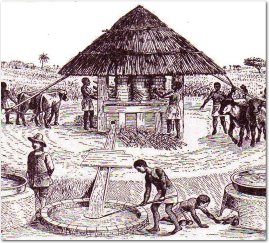
Trapiche primitivo.
|
 ugar cane was brought to the New World from the Canary
Islands by Christopher
Columbus, and introduced
into the island of Puerto
Rico from Santo
Domingo, in 1515, to be
cultivated on the
banks of the Toa river
at the Crown's experimental
farm. ugar cane was brought to the New World from the Canary
Islands by Christopher
Columbus, and introduced
into the island of Puerto
Rico from Santo
Domingo, in 1515, to be
cultivated on the
banks of the Toa river
at the Crown's experimental
farm.
The first grinding mill
was established in
Añasco, by Tomás de Castellón
in 1523 and
was operated with oxen.
From 1548 hundreds
of mills operated by water
power (norias)
making moscabado sugar
began operations.
The industry was in the
hands of small landowners
whose enterprises succeeded
or failed depending
on the price of sugar in
the market or the
whims of the Spanish Crown.
The first "Centrales" or factories
with equipment operated
by steam were established
from 1873 to 1876 - whereby
the sugar crystals
got separated from the
molasses in centrifuges.
The machinery was purchased
in England or
France. The outmoded smaller
mills (trapiches)
vanished after the end
of slavery in 1873.
| First factory to modernized by expanding
its land holdings
was San Vicente (Leonardo
Igaravides in Vega
Baja) and was soon followed
by Coloso (Emilio
Vadi in Aguada), and Luisa (Maunabo), San Felipe
(Naguabo), San Luis
(Carolina), and Josefina
(Río Piedras). |
|
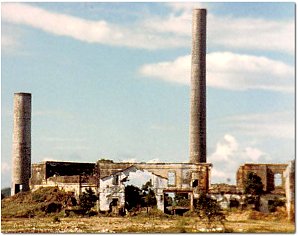
Ruinas de la central San Vicente; 1984. |
At the 1882 Exposition in Ponce, two owners
received gold and honorary
medals for the
high quality sugar obtained
with the new
process: these were Vadi
and the Cabrera
Brothers from the Boca
Chica hacienda close
to Ponce. But in 1882 there
were still only
five or six centrales working
in the island
of Puerto Rico.
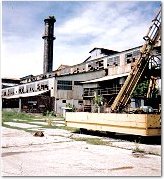 |
|
|
 |
| Central Coloso, Aguada, en ruinas. |
|
|
Central San Vicente; 1960. |
After sovereignty was transferred to the
US in 1898, the industry
grew with the impetus
of the sugar interests
from the mainland.
From then until the Spring
of 2000, when
Coloso closed after its
last harvest, sugar
cane was the most important
cash crop of
the island of Puerto Rico.
The industry struggled
through the XX century
with market price
competition, a diminishing
and expensive
labor force, the cost of
transportation,
the sugar quota system
and the need to fertilize
and irrigate the land,
so harsh that eventually
became bankrupt. In 1936
there were approximately
43 centrales operating
under a sugar quota
of 909,445 short tons (2,000
lbs or net ton)
This had been established
by the Jones-Costigan
Act, which allowed Puerto
Rico to ship the
raw product to the USA
without payment of
duty.
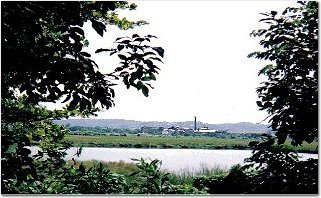 |
|
| Central Coloso. |
|
Thirty four centrales ceased operations between
1942 and 1977. The largest
survived for another
decade: Cambalache (Arecibo)
and Guánica
(Ensenada) closed in 1981
to be followed
by Aguirre (Salinas) in
1990, Mercedita in
1994, La Plata (San Sebastián)
1996, and
finally Coloso and Roig
(Yabucoa) in 2000.
An industry and a way of
life came to an
end. The "colonos" or farmers
who
planted the crops and sent
it to the factory
to be processed, hardly
ever saw their efforts
compensated at the time
their sugar was sold.
The growing period for
the crop usually took
fourteen months or more,
from planting during
the last four months of
the year until grinding
began following January.
It was necessary
to replant every four years
or so. Most raw
sugar was shipped to refineries
in the East
Coast but by the second
half of the century
Guánica, Mercedita, Igualdad,
Roig and San
Francisco had acquired
refining machinery.
The workers abandoned the
island after WWII
for full time jobs and
better wages elsewhere
and the colonos abandoned
the sugar industry.
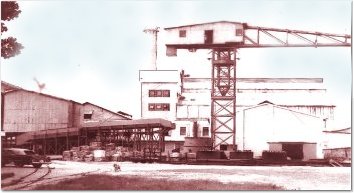 |
| Central San Vicente siendo desmantelada. |
José R. Abad writing in 1882 foresaw the
end when he observed that
the owners had
insisted in expanding (investment
of capital)
by acquiring more powerful
machinery and
lands, absorbing every
small agricultural
plot and therefore eliminating
other forms
of agriculture, and eventually
redistributing
the riches of the land
to the detriment of
the island's social well
being. Looking back,
we could say that changes
were to come with
the whims of a more modern
century and rethinking
of the choices made under
another set of
circumstances.
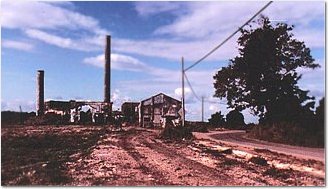 |
| Ruinas de lo que fue la Central San Vicente. |
|
Centrales in operation in 1940, location
(closest town) and
date they closed down:
Playa Grande in Vieques
(1942); Carmen in
Vega Alta (1945);
Caribe in Salinas (1946);
Boca Chica in Juana
Díaz (1946); Herminia
in Villalba (1947);
Santa Barbara in Jayuya
(1948); Pellejas
in Adjuntas (1949); San
Joseé in Río Piedras
(1952); Constancia in
Ponce (1954); Rochelaise
in Mayagüez (1957);
Victoria in Carolina
(1957); Pasto Viejo
in Humacao (1958),
Ejemplo in Humacao (1961);
Constancia in Toa
Baja (1962); Guamaní in
Guayama (1963); Juanita
in Bayamón (1963);
Plazuela in Barceloneta
(1963). |
|
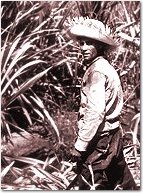 |
Canóvanas in Loíza (1965); Santa Juana in
Caguas (1966); Cayey in
Cayey (1967); Machete
in Guayama (1967); Rufina
in Guayanilla (1967);
San Vicente in Vega Baja
(1967); Soller in
Camuy (1968); Río LLano
in Camuy (1970);
Lafayette in Arroyo (1971);
Los Caños in
Arecibo (1972); Monserate
in Manatí (1972);
Juncos in Juncos (1973);
Cortada in Santa
Isabel (1974); Eureka in
Hormigueros (1977);
Fajardo in Fajardo (1977);
Igualdad in Añasco
(1977); and San Francisco
in Guayanilla (1977).
FUENTES:
1. Manual of Sugar Companies.
Farr &
Co, New York, 1937.
2. Gaztambide y Arán. La
Isla de Puerto Rico.
Rand MacNally y Co., 1941.
3. Hernández Méndez, Eugenio.
Crónicas de
Puerto Rico: desde la conquista
hasta nuestros
días 1493-1955. Editorial
de la Universidad
de Puerto Rico, 1969.
|
|